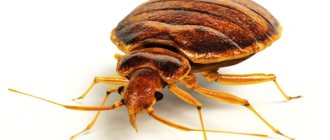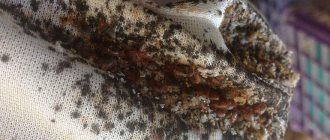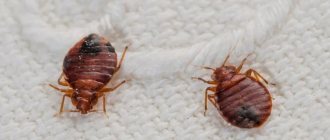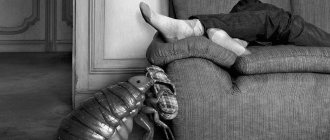How do bedbugs behave after treatment?
The behavior of parasites after treatment depends on:
- composition of the drug used for disinfestation;
- the concentration of the insecticide that fell directly on the insect;
- accessibility of nests for direct penetration of chemicals into them.
Modern drugs have a complex composition of several components with different mechanisms of action on parasites.
After baiting bedbugs, you can observe the following:
- Some drugs cause rapid death of insects, and some of them die directly during disinfestation.
- It feels like there are a lot more parasites. This is wrong. Insects begin to run out of treated shelters and try to look for new ones, including from neighbors.
- Bedbugs become more active, appear during the daytime, and hide in unusual places. This is the effect of insecticides aimed at paralyzing the nervous system. Gradually, the activity of the parasites decreases, disorientation appears, and then the death of the insects.
Bedbugs that have received a tiny dose of poison continue their normal lifestyle. They can also bite at night and reproduce in nests that go undetected during treatment.
How long should I wait
In many ways, the death of insects depends on the quality of disinfestation. Even analyzing the features of the room, identifying areas where bed bugs accumulate, and thoroughly treating bedding and furniture cannot guarantee that bed bugs will stop biting. These insects like to hide in secluded places, especially to lay larvae there.
To understand why bed bugs still bite after treatment, you need to know two important points regarding the life activity of this species:
- Each female lays up to 20 eggs at one time, and up to 500 throughout her life;
- Development in the egg lasts several days, and the adult becomes an adult within a month.
Such scientific data suggests that a month is the minimum period for completely getting rid of bedbugs. During this period, it will not be possible to avoid insect bites. Additional treatment of the premises after a couple of weeks will help to significantly reduce the number of bed bugs and consolidate the effect of the first disinfestation.
On what day after disinfestation do bed bugs disappear?
None of the manufacturers of pesticides will say exactly how long bedbugs live after being treated with it. It depends on many factors. A drug that gets directly onto the body of the parasite can cause rapid death of the insect. It is absorbed through the outer skin and respiratory tract.
Corpses
In this way, it is possible to destroy part of the bedbug population. The life expectancy of the remaining individuals is from one to two weeks, depending on the composition of the drug, the quality of processing and the stage of development of the insect.
Some bedbugs survive even the most thorough disinsection if they have previously developed immunity to the type of insecticide used.
Treatment of a room without professional equipment suffers from lower quality and it is not possible to unequivocally answer the question of how many days the bedbugs will disappear. You can notice insects crawling around the apartment even after two weeks.
Aerosol and liquid preparations have a faster effect compared to powders. For example, when using Tsifoks, the bug dies in 20–30 minutes, and Dust Absolute will cause the death of most insects in a few days.
Professional treatment for bedbugs
The most effective way to combat bedbugs is to professionally sanitize the premises against bedbugs. Today, there are many organizations that offer disinfestation services in private and industrial premises. The methods that these companies use are effective and help get rid of pests. During sanitization, specialists spray a liquid chemical onto all surfaces where bedbugs can run. It happens that professional preparations are characterized by the presence of a faint odor, but in most cases products without extraneous fragrances are used.
Interestingly, after chemical treatment no traces remain. The maximum that can happen is a slight presence of a transparent whitish coating, which can be easily removed with a damp cloth.
Specialists process the entire room, including upholstered furniture, baseboards, window and door openings, cabinets, etc. It is important to organize such activities in all rooms, not just the master bedroom. Only such active measures can guarantee high efficiency in killing bedbugs.
It is worth noting that not all products can help completely get rid of pests. The effectiveness depends, first of all, on the chosen means to combat parasites and on how many of them are present in the apartment.
So, to treat the premises, special services use the most effective drugs, among which are:
- Professional insecticides, which can only be used if you have special equipment and have the skills to work with them. This may be the use of “Klopoveron”, “Effective Ultra”, “Sinuzan”, “Chlorprimarka”, “Extermina-F”, “Xulata-25” or “Microcin”. These products have a long-lasting effect and a high degree of effectiveness.
- Special generators, hair dryers and devices that have a high cost, and therefore hardly anyone will buy them on their own.
So, the main question arises - how long does it take for bedbugs to die? After such treatments, the effect begins to be observed after 30-50 minutes, when the bugs die that received a certain dose of chemicals. However, a number of insects may be resistant or less susceptible to their harmful effects. It is worth noting that the complete disappearance of bed parasites occurs within 5-6 days, so all surfaces need to be treated without exception. Since the surviving bedbugs begin to emerge from their hiding places in search of untreated places and move along them to neighboring rooms or apartments.
To treat clothes against bedbugs, you can use the boiling method, which will take about 30 minutes. You can also wash it in a washing machine by setting the temperature within 50 °C. Items that cannot be boiled or machine washed should be taken to dry cleaning. It is important to process not only clothes, but also soft toys, window textiles, and other interior items. It is better to do this before the arrival of professional service.
How to get rid of odor after disinfestation?
Manufacturers of bedbug repellents offer unscented, fragranced or regular options. When choosing the first two options, you need to take into account that they are most likely less toxic to bedbugs, having their own aroma, albeit a weak one.
To get rid of the first pungent odor after baiting bedbugs, after finishing the treatment you need to ventilate the room closed for conservation. It is necessary to create a draft and, if possible, not stay in the apartment. In winter, initial ventilation should take at least 1–2 hours, depending on the outside temperature. In summer - 3–4 hours.
Carpets and textiles retain the smell for a long time after disinsection. Therefore, it is better to immediately remove the curtains and wash them, and clean the carpets with a damp brush. You can't do any general cleaning for another two to three weeks.
The concentration of unpleasant odor can be reduced by eliminating the remains of bedbugs, but only using the dry method, and daily ventilation.
The unpleasant aroma will finally disappear after general cleaning and cleaning of furniture covers.
Attention! If you need to get rid of the smell urgently, then you can additionally order deodorization of the premises from the same organizations that do the treatment of premises. It must be borne in mind that this will reduce the effect of disinfestation.
Preparing and processing the room
In order for bedbug treatment to have the maximum effect, preliminary preparation of the apartment is necessary.
The procedure looks like this:
Adults die within two hours, but their eggs will continue to remain viable, so for several days after disinfestation there is no need to carry out wet cleaning; the nymphs hatched from the eggs will move to the treated areas and ultimately die.
The most effective option is not to return home for ten days; during this period, both adult bedbugs and their larvae will die.
On the tenth day, you should carry out general cleaning, clean every corner, and remove dead bedbugs. You should also wash your laundry thoroughly. You should not use cheap pesticides; they are ineffective and have a lot of disadvantages.
Reasons why bedbugs may remain indoors after treatment
If the bedbugs do not disappear after treatment, but continue to bite at night, then there may be several reasons for this:
- Too little time passed, and the drug did not have time to act on all individuals.
- Poor preparation of the premises for disinfestation. For example, during treatment, some bedbugs remained under the dust and were not exposed to poison.
- Spraying was carried out with violations. Not all shelters have been processed.
- A low-quality product was used, or the solution was made too weak.
- Bedbugs have already been treated with a similar drug, and they have acquired immunity. In this case, the bedbugs do not disappear, but continue their normal lifestyle.
- Repeated disinfestation was not carried out and a new generation of bedbugs appeared.
- General cleaning was done before the recommended time had expired, which allowed some individuals to survive.
- After treatment, the bedbugs disappeared for some time, and then appeared again. Most likely, they returned from their neighbors, who also started destroying them. This happens quite often if preventative work has not been carried out in the apartment.
Preparing the premises
Folk remedies for treating bedbugs
For those who do not want to come into contact with chemicals, folk remedies for fighting parasites will be of interest. They are based on exposure through the use of strong aromas. For this use:
- More than 25 species of different plants, from which either powder is prepared, like dried Dalmatian chamomile flowers, or decoctions, which are used to treat the room, clothing and furniture.
- Table vinegar. It is used to treat the apartment, as well as to get rid of bite marks.
- Essential oils that can drive parasites out of their shelters.
- Various sachets using dry lavender, citrus peels, wormwood, mint, which drive out insects and at the same time bring a deodorizing effect.
- Ammonia and turpentine, which are capable of destroying the abode of parasites upon direct contact between them.
It is worth noting that the use of traditional methods of control is not always effective, since the effect of aromatic herbs, for example, is rather short-lived and soon disappears, which leads to the return of bedbugs to their shelters. Such methods have their place, but they are best used in combination with other methods or as a preventive measure.
Folk remedies for bedbugs
Thus, as we see, there are many ways to deal with such unwanted guests as bedbugs. All of them have many positive aspects, but there are also some disadvantages that should be taken into account when choosing the most effective method, which is suitable in each individual case. The main thing is a timely reaction from the owners who notice parasites in the house. The sooner the fight to destroy them begins, the higher the chances of success. And properly carried out disinfection and compliance with all safety measures guarantee quick disposal of bedbugs, without harm to health.
If you find an error or inaccuracy, please select a piece of text and press Ctrl+Enter.
In what cases is re-processing necessary?
Repeated disinfection of the premises is almost always recommended. There are very rare cases when it is possible to remove bedbugs the first time and for a long time. Experts advise doing it two to three weeks after the previous one. But if one and a half to two months have passed after the first treatment, and the bugs do not disappear, then the question of whether to carry out or not disappears by itself.
When repeating disinfestation, you must:
- Change the drug to another. If bedbugs remain after treatment, it is possible that they are resistant to the device used. Most often this happens in apartment buildings where neighbors poison insects. In private households, this happens after repeated attempts to get rid of parasites.
- Conduct a re-inspection of the premises aimed at finding undetected nests.
You can carry out repeated treatment against bedbugs yourself in cases where the number of insects has decreased significantly after the first disinfestation. It does not require such large-scale actions as the previous one.











